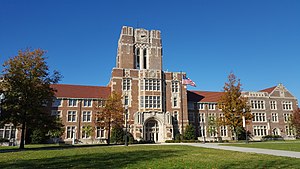University of Tennessee (Knoxville): Difference between revisions
Pat Palmer (talk | contribs) m (→Cost to attend) |
Pat Palmer (talk | contribs) m (→Research) |
||
| (5 intermediate revisions by the same user not shown) | |||
| Line 10: | Line 10: | ||
==Research== | ==Research== | ||
The Carnegie Classification of Institutions of Higher Education ranks the University of Tennessee, Knoxville as "R1: Doctoral Universities – Very high research activity".<ref>{{cite web |title=Carnegie Classifications Institution Lookup |url=https://carnegieclassifications.iu.edu/lookup/view_institution.php?unit_id=190415 |publisher=Center for Postsecondary Education |website=carnegieclassifications.iu.edu |access-date=July 18, 2020}}</ref> The university has ties to nearby Oak Ridge National Laboratory, allowing for considerable research opportunities for faculty and students in the sciences. | The Carnegie Classification of Institutions of Higher Education ranks the University of Tennessee, Knoxville as "R1: Doctoral Universities – Very high research activity".<ref>{{cite web |title=Carnegie Classifications Institution Lookup |url=https://carnegieclassifications.iu.edu/lookup/view_institution.php?unit_id=190415 |publisher=Center for Postsecondary Education |website=carnegieclassifications.iu.edu |access-date=July 18, 2020}}</ref> The university has ties to nearby Oak Ridge National Laboratory, allowing for considerable research opportunities for faculty and students in the sciences. ⁷Also affiliated with the university are: | ||
* the Howard H. Baker Jr. Center for Public Policy | |||
* the University of Tennessee Anthropological Research Facility | |||
* the University of Tennessee Arboretum (250 acres) - in Oak Ridge, TN | |||
* the University of Tennessee Medical Center (a Level I trauma center) | |||
==Satellite campuses== | ==Satellite campuses== | ||
Revision as of 05:50, 26 July 2024
The University of Tennessee is a public land-grant[1] university whose largest and main campus is in Knoxville, Tennessee.
Student body size and employment
In fall of 2023, there were 36,304 students[2] on the campus, including graduate students and postdocs. Besides a faculty of nearly 2000, the Knoxville campus employs administrative staff of nearly 10,000 people.
Cost to attend
As of 2024, tuition and fees for one year were $13,812 (in-state) or $30,704 (out-of-state). The amount of money needed to attend for one year including housing and all other estimated costs to live was $35,156 (in-state) or $54,600 (out-of-state).
Research
The Carnegie Classification of Institutions of Higher Education ranks the University of Tennessee, Knoxville as "R1: Doctoral Universities – Very high research activity".[3] The university has ties to nearby Oak Ridge National Laboratory, allowing for considerable research opportunities for faculty and students in the sciences. ⁷Also affiliated with the university are:
- the Howard H. Baker Jr. Center for Public Policy
- the University of Tennessee Anthropological Research Facility
- the University of Tennessee Arboretum (250 acres) - in Oak Ridge, TN
- the University of Tennessee Medical Center (a Level I trauma center)
Satellite campuses
Several smaller branch campuses to the University of Tennessee system exist across the state.
Notes
- ↑ Read about land-grant universities in Wikipedia.
- ↑ University of Tennessee, Knoxville Fact Book.
- ↑ Carnegie Classifications Institution Lookup. Center for Postsecondary Education.
